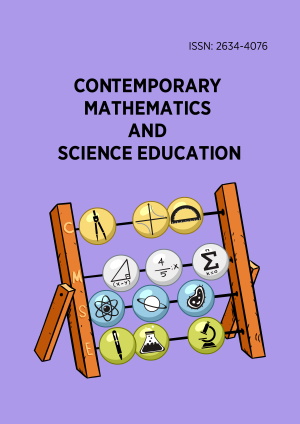Research Article
Habits of Mathematical Thinking and Development of Heuristics
More Detail
1 University of Texas at San Antonio, USA* Corresponding Author
Contemporary Mathematics and Science Education, 3(1), January 2022, ep22002, https://doi.org/10.30935/conmaths/11521
Submitted: 07 July 2021, Published: 09 January 2022
OPEN ACCESS 1769 Views 1245 Downloads
ABSTRACT
Psychological theory indicates that human use heuristics, the psychology of mental shortcuts, to make decisions, solve problems, or learn new knowledge. In this article, I will discuss how some common mathematical mistakes generate from the heuristics process while students learn mathematics or solve mathematics problems, and how we may help students avoid the hurdle of heuristic bias. Constructing heuristics ability of non-linear thinking will be discussed to shed light on teaching students high order of mathematical thinking.
CITATION (APA)
Liang, S. (2022). Habits of Mathematical Thinking and Development of Heuristics. Contemporary Mathematics and Science Education, 3(1), ep22002. https://doi.org/10.30935/conmaths/11521
REFERENCES
- Ausubel, D. P. (1968). Educational psychology: A cognitive view. Holt, Rinehart &Winston.
- Burns, M. (2000). About teaching mathematics: A K-8 resource. Math Solutions Publications.
- Cai, J. (2010). Commentary on problem solving heuristics, affect, and discrete mathematics: A representational discussion. In: B. Sriraman, & L. English (Eds.), Theories of mathematics education (pp. 251-258). Springer. https://doi.org/10.1007/978-3-642-00742-2_25
- Chevallard, Y., & Bosch, M. (2020). Didactic transposition in mathematics education. In: S. Lerman (Ed.), Encyclopedia of mathematics education. Springer. https://doi.org/10.1007/978-3-030-15789-0_48
- Gigerenzer, G., & Gaissmaier, W. (2011). Heuristic decision making. The Annual Review of Psychology, 62, 451-482. https://doi.org/10.1146/annurev-psych-120709-145346
- González-Martín, A. S., Bloch, I., Durand-Guerrier, V., & Maschietto, M. (2014). Didactic situations and didactical engineering in university mathematics: Cases from the study of calculus and proof. Research in Mathematics Education, 16(2), 117-134. https://doi.org/10.1080/14794802.2014.918347
- Hegedus, S. J. (2010). Preface to part VI: The fundamental cycle of concept construction underlying various theoretical frameworks by John Pegg and David Tall. In B. Sriraman, & L. English (Eds.), Theories of mathematics education. Springer.
- Kahneman, D. (2003). Maps of bounded rationality: Psychology for behavioral economics. American Economic Review, 93(5), 1449-1475. https://doi.org/10.1257/000282803322655392
- Kahneman, D. (2011). Thinking, fast and slow. Farrar, Straus and Giroux.
- Kroll, D. L., & Miller, T. (1993). Insights from research on mathematical problem solving in the middle grades. In D. T. Owens (Ed.), Research ideas for the classroom: Middle grades mathematics (pp. 58-77). National Council of Teachers of Mathematics.
- Lambdin, D. (2003). Benefits of teaching through problem solving. In F. Lester (Ed.), Teaching mathematics through problem solving (pp. 3-14). National Council of Teachers of Mathematics.
- Lester, F. K., & Cai, J. (2016). Can mathematical problem solving be taught? Preliminary answers from 30 years of research. In: P. Felmer, E. Pehkonen, & J. Kilpatrick (Eds), Posing and solving mathematical problems: Advances and new perspectives. Springer. https://doi.org/10.1007/978-3-319-28023-3_8
- Lester, F. K., & Charles, R. (2003). Teaching mathematics through problem solving: Pre-K-grade 6. National Council of Teachers of Mathematics.
- Liang, S. (2021a). Equivalence and substitution: Tools for teaching meaningful mathematics. For the Learning of Mathematics, 41(1), 41-43.
- Liang, S. (2021b). Deepening mathematics learning by making variation available in teaching. Journal.of Higher Education Theory and Practice, 21(12), 1-9. https://doi.org/10.33423/jhetp.v21i12
- Liljedah, P., Trigo, M. S., Malaspina, U., & Bruder, R. (2016). Problem solving in mathematics education. Springer. https://doi.org/10.1007/978-3-319-40730-2
- Melhuish, K., & Czocher, J. A. (2020). Division is pretty much just multiplicationFor the Learning of Mathematics, 40(2), 38-43.
- Nunokawa, K. (2005). Mathematical problem solving and learning mathematics: What we expect students to obtain. The Journal of Mathematical Behavior, 24(3-4), 325-340. https://doi.org/10.1016/j.jmathb.2005.09.002
- Polya, G. (1945). How to solve it. Princeton University Press. https://doi.org/10.1515/9781400828678
- Salomon, G., & Perkins, D. N. (1998). Individual and Social Aspects of Learning. Review of Research in Education, 23, 1- 24.
- Schoenfeld, A. H. (1985). Mathematical problem solving. Academic Press, INC.
- Tversky, A., & Kahneman, D. (1973). Availability: A heuristic for judging frequency and probability. Cognitive Psychology, 5(2), 207-232. https://doi.org/10.1016/0010-0285(73)90033-9
- Tversky, A., & Kahneman, D. (1974). Judgement under uncertainty: Heuristics and biases. Science, 185(4157), 1124-1131. https://doi.org/10.1126/science.185.4157.1124
- Van de Walle, J. A. (2007). Teaching mathematics for understanding. ptgmedia.pearsoncmg.com. http://ptgmedia.pearsoncmg.com/imprint_downloads/merrill_professional/Van_de_Walle_9780132824828.pdf

 The articles published in this journal are licensed under the CC-BY Creative Commons Attribution International License.
The articles published in this journal are licensed under the CC-BY Creative Commons Attribution International License.